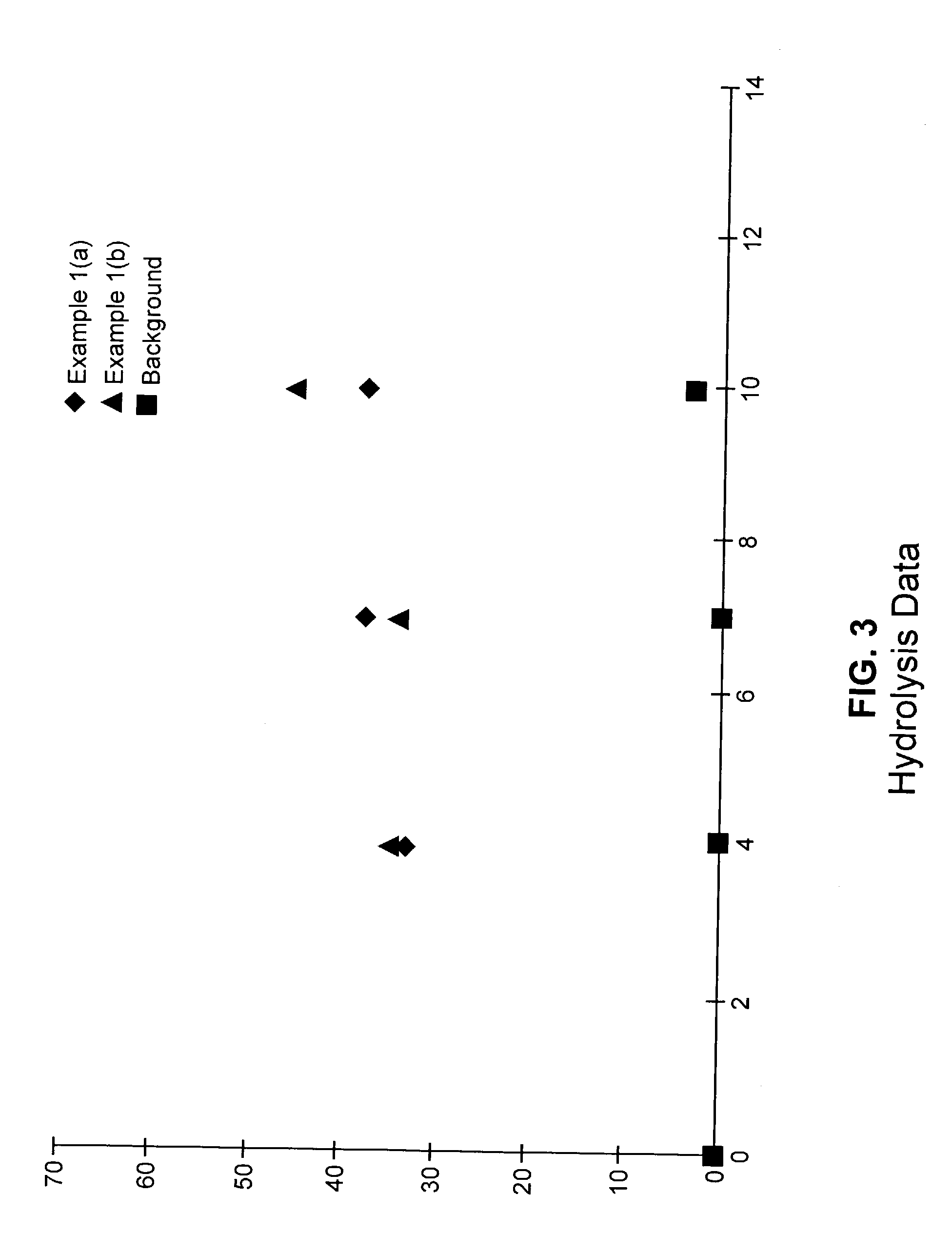Olefin copolymers containing hydrolytically cleavable linkages and use thereof in degradable products
a technology of hydrolytically cleavage and olefin, which is applied in the field of olefin copolymers, can solve the problems of insufficient stability for storage and transportation, lack of additional properties that are desired or necessary to provide more commercially acceptable products, and inability to meet the requirements of use,
- Summary
- Abstract
- Description
- Claims
- Application Information
AI Technical Summary
Benefits of technology
Problems solved by technology
Method used
Image
Examples
example 1
Preparation of Ethylene / 3,9-Divinyl-2,4,8,10-Tetraoxaspiro[5.5]Undecane Copolymer using a Zirconium Metallocene Complex as Catalyst
[0161]This example describes copolymerization of ethylene with 3,9-divinyl-2,4,8,10-tetraoxaspiro[5.5]undecane, i.e., a hydrolyzable comonomer containing a hydrolytically cleavable bicyclic acetal linkage, the comonomer having the structure
[0162]
using a metallocene catalyst. The catalyst used was (CH3)2Si(C16H12)2ZrCl2 (molecular weight 628.83, available from Hoechst; C16H12≡2-methyl-4-phenylindenyl), the molecular structure of which is as follows:
[0163]
[0164]A glass reactor was flushed with argon and charged with 100 mL of toluene and 1.0 g (5.38 mmol) of 3,9-divinyl-2,4,8,10-tetraoxaspiro[5.5]undecane. The reactor was then flushed with ethylene, and the solution was stirred with an overhead mechanical stirrer. A solution of 0.5 g TMA (trimethylaluminum)-free MAO (methyl aluminoxane) in 2 mL toluene was added, and the reactor was pressurized with ethyle...
example 2
Preparation of Ethylene / 3,9-Divinyl-2,4,8,10-Tetraoxaspiro[5.5]Undecane Copolymer using a Titanium Metallocene Complex as Catalyst
[0168]The reaction of Example 1 was repeated using 0.0123 mmol of a titanium metallocene complex as the reaction catalyst. The catalyst was (CH3)2Si(1,2,3,4-tetramethyl cyclopentadiene)(t-Bu)TiCl2 (Dow), the molecular structure of which is as follows:
[0169]
[0170]The copolymer was isolated by filtration, washed with methanol, and dried under vacuum for 16 hours to give 1.3 g of a powdery solid.
example 3
Preparation of Ethylene / Diallyltetramethyldisiloxane Copolymer
[0171]This example describes copolymerization of ethylene with diallyldimethyllsiloxane, a hydrolyzable comonomer containing a hydrolytically cleavable siloxane linkage, the comonomer having the structure
[0172]
using the metallocene catalyst of Example 1.
[0173]A glass reactor fitted with an overhead stirrer was charged with 100 mL of toluene and 1.52 g (8.44 mmol) of diallyldimethylsiloxane. The reactor was then purged and degassed by repeated cycles of pressurizing with argon to 25 psig and evacuation under vacuum. A solution of 0.5 g of TMA-free MAO in 2 mL of toluene was added under argon and the reactor pressurized with ethylene to 25 psig for 1 minute. The pressure was released and a catalyst / MAO mixture, prepared from a freshly prepared mixture of 0.5 g of TMA-free MAO in 2 mL of toluene and 0.0175 mmoles of catalyst in 3 mL of toluene was added.
[0174]The reactor was then pressurized to 45 psi ethylene and isolated f...
PUM
| Property | Measurement | Unit |
|---|---|---|
| melting points | aaaaa | aaaaa |
| pressures | aaaaa | aaaaa |
| temperatures | aaaaa | aaaaa |
Abstract
Description
Claims
Application Information
 Login to View More
Login to View More - R&D
- Intellectual Property
- Life Sciences
- Materials
- Tech Scout
- Unparalleled Data Quality
- Higher Quality Content
- 60% Fewer Hallucinations
Browse by: Latest US Patents, China's latest patents, Technical Efficacy Thesaurus, Application Domain, Technology Topic, Popular Technical Reports.
© 2025 PatSnap. All rights reserved.Legal|Privacy policy|Modern Slavery Act Transparency Statement|Sitemap|About US| Contact US: help@patsnap.com



